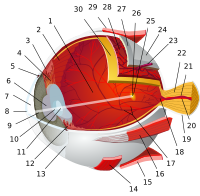Sclera
It is continuous with the dura mater and the cornea, and maintains the shape of the eyeball, offering resistance to internal and external forces, and provides an attachment for the extraocular muscle insertions.
Along with the vessels of the conjunctiva (which is a thin layer covering the sclera), those in the episclera render the inflamed eye bright red.
[6] In many vertebrates, the sclera is reinforced with plates of cartilage or bone, together forming a circular structure called the sclerotic ring.
[8] Histologically speaking, it is characterized as dense connective tissue made primarily of type 1 collagen fibers.
Moreover, the cornea bears more mucopolysaccharide (a carbohydrate that has among its repeating units a nitrogenous sugar, hexosamine) to embed the fibrils.
It is theorized that this adaptation evolved because of humans’ social nature as the eye became a useful communication tool in addition to a sensory organ.
[11] Animal researchers have also found that, in the course of their domestication, dogs have also developed the ability to pick up visual cues from the eyes of humans.
A visibly white sclera is perceived as a sign of good health and youthfullness,[13] this could have been a criterion of selection when looking for a mate.
However, if the sclera is ruptured by a blunt force or is penetrated by a sharp object, the recovery of full former vision is usually rare.
Hemorrhaging and a dramatic drop in intraocular pressure are common, along with a reduction in visual perception to only broad hand movements and the presence or absence of light.
Sufficiently small objects which become embedded and which are subsequently left untreated may eventually become surrounded by a benign cyst, causing no other damage or discomfort.
Even relatively low-temperature molten metals when splashed against an open eye have been shown to cause very little damage to the sclera, even while creating detailed casts of the surrounding eyelashes.
